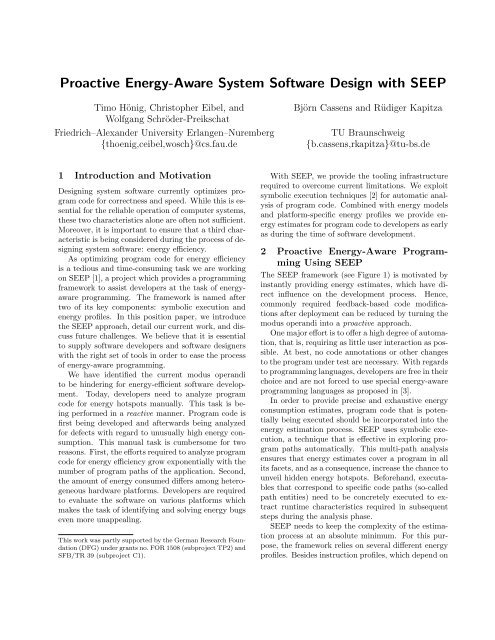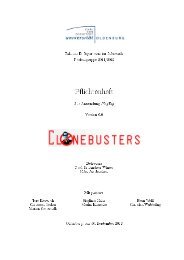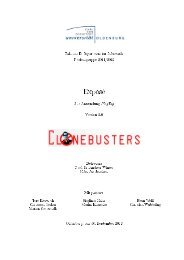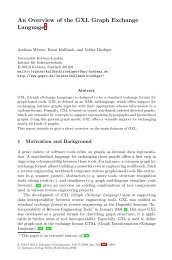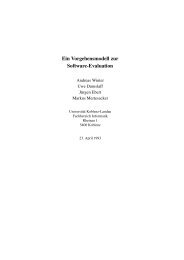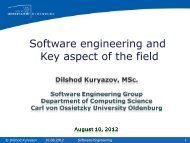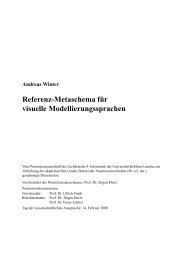Proactive Energy-Aware System Software Design with SEEP - CS 4
Proactive Energy-Aware System Software Design with SEEP - CS 4
Proactive Energy-Aware System Software Design with SEEP - CS 4
Create successful ePaper yourself
Turn your PDF publications into a flip-book with our unique Google optimized e-Paper software.
<strong>Proactive</strong> <strong>Energy</strong>-<strong>Aware</strong> <strong>System</strong> <strong>Software</strong> <strong>Design</strong> <strong>with</strong> <strong>SEEP</strong><br />
Timo Hönig, Christopher Eibel, and<br />
Wolfgang Schröder-Preikschat<br />
Friedrich–Alexander University Erlangen–Nuremberg<br />
{thoenig,ceibel,wosch}@cs.fau.de<br />
Björn Cassens and Rüdiger Kapitza<br />
TU Braunschweig<br />
{b.cassens,rkapitza}@tu-bs.de<br />
1 Introduction and Motivation<br />
<strong>Design</strong>ing system software currently optimizes program<br />
code for correctness and speed. While this is essential<br />
for the reliable operation of computer systems,<br />
these two characteristics alone are often not sufficient.<br />
Moreover, it is important to ensure that a third characteristic<br />
is being considered during the process of designing<br />
system software: energy efficiency.<br />
As optimizing program code for energy efficiency<br />
is a tedious and time-consuming task we are working<br />
on <strong>SEEP</strong> [1], a project which provides a programming<br />
framework to assist developers at the task of energyaware<br />
programming. The framework is named after<br />
two of its key components: symbolic execution and<br />
energy profiles. In this position paper, we introduce<br />
the <strong>SEEP</strong> approach, detail our current work, and discuss<br />
future challenges. We believe that it is essential<br />
to supply software developers and software designers<br />
<strong>with</strong> the right set of tools in order to ease the process<br />
of energy-aware programming.<br />
We have identified the current modus operandi<br />
to be hindering for energy-efficient software development.<br />
Today, developers need to analyze program<br />
code for energy hotspots manually. This task is being<br />
performed in a reactive manner. Program code is<br />
first being developed and afterwards being analyzed<br />
for defects <strong>with</strong> regard to unusually high energy consumption.<br />
This manual task is cumbersome for two<br />
reasons. First, the efforts required to analyze program<br />
code for energy efficiency grow exponentially <strong>with</strong> the<br />
number of program paths of the application. Second,<br />
the amount of energy consumed differs among heterogeneous<br />
hardware platforms. Developers are required<br />
to evaluate the software on various platforms which<br />
makes the task of identifying and solving energy bugs<br />
even more unappealing.<br />
This work was partly supported by the German Research Foundation<br />
(DFG) under grants no. FOR 1508 (subproject TP2) and<br />
SFB/TR 39 (subproject C1).<br />
With <strong>SEEP</strong>, we provide the tooling infrastructure<br />
required to overcome current limitations. We exploit<br />
symbolic execution techniques [2] for automatic analysis<br />
of program code. Combined <strong>with</strong> energy models<br />
and platform-specific energy profiles we provide energy<br />
estimates for program code to developers as early<br />
as during the time of software development.<br />
2 <strong>Proactive</strong> <strong>Energy</strong>-<strong>Aware</strong> Programming<br />
Using <strong>SEEP</strong><br />
The <strong>SEEP</strong> framework (see Figure 1) is motivated by<br />
instantly providing energy estimates, which have direct<br />
influence on the development process. Hence,<br />
commonly required feedback-based code modifications<br />
after deployment can be reduced by turning the<br />
modus operandi into a proactive approach.<br />
One major effort is to offer a high degree of automation,<br />
that is, requiring as little user interaction as possible.<br />
At best, no code annotations or other changes<br />
to the program under test are necessary. With regards<br />
to programming languages, developers are free in their<br />
choice and are not forced to use special energy-aware<br />
programming languages as proposed in [3].<br />
In order to provide precise and exhaustive energy<br />
consumption estimates, program code that is potentially<br />
being executed should be incorporated into the<br />
energy estimation process. <strong>SEEP</strong> uses symbolic execution,<br />
a technique that is effective in exploring program<br />
paths automatically. This multi-path analysis<br />
ensures that energy estimates cover a program in all<br />
its facets, and as a consequence, increase the chance to<br />
unveil hidden energy hotspots. Beforehand, executables<br />
that correspond to specific code paths (so-called<br />
path entities) need to be concretely executed to extract<br />
runtime characteristics required in subsequent<br />
steps during the analysis phase.<br />
<strong>SEEP</strong> needs to keep the complexity of the estimation<br />
process at an absolute minimum. For this purpose,<br />
the framework relies on several different energy<br />
profiles. Besides instruction profiles, which depend on
Source Code<br />
<strong>Energy</strong> Estimates<br />
Tooling<br />
Symbolic Execution<br />
Code Path Exploration<br />
Concrete Execution<br />
Code Analysis<br />
<strong>Energy</strong> Profiles<br />
Trace Database<br />
Persistent Data<br />
Figure 1: Overview of the <strong>SEEP</strong> architecture.<br />
a CPU’s instruction set architecture, this includes energy<br />
profiles for device-specific peripherals (e.g., network<br />
or file transfer costs). By means of virtualization<br />
environments, energy estimates can be calculated<br />
<strong>with</strong>out the need to execute code on target platforms.<br />
This profile-driven approach is extended by further<br />
persistent data, which is populated iteratively <strong>with</strong><br />
entries for functions that have been analyzed by the<br />
framework. Such function entries consist, amongst<br />
others, of symbolic expressions, which can be exploited<br />
to interpolate a function’s energy consumption.<br />
Thus, whenever the control flow of a consecutive<br />
execution run reaches functions that have been analyzed<br />
previously, symbolic execution can be omitted.<br />
This shortcut saves great amounts of analysis time.<br />
Furthermore, concretely executing path entities to<br />
deduct a target’s runtime behavior can be parallelized<br />
for heterogeneous platforms using virtualization techniques.<br />
At this, our approach does not make any restrictions<br />
as long as target platforms and their peripheral<br />
devices can be measured accurately according<br />
to a precise energy model. From a CPU’s point of<br />
view, such models must contain both basic and interinstruction<br />
energy costs which vary in dependence of<br />
a CPU’s capabilities (e.g., instruction pipelining).<br />
3 Development Process Integration<br />
Currently, we explore different possibilities to consolidate<br />
<strong>SEEP</strong> <strong>with</strong> integrated development environments<br />
(IDEs) such as Eclipse. As basis of decisionmaking,<br />
energy estimates are provided at function<br />
level. These estimates are displayed in the IDE so that<br />
developers can correlate program code (i.e., source<br />
code of a function and input parameters) <strong>with</strong> energy<br />
consumption estimates.<br />
During the development phase, code changes are<br />
being reported to the backend of the <strong>SEEP</strong> framework.<br />
Functional changes trigger a reevaluation of<br />
affected program paths. To ensure consistency the<br />
trace database is being updated incrementally. Whenever<br />
code changes cause a significant negative impact<br />
on the program code currently in development, the<br />
developer is being notified concerning this matter.<br />
If alternatives for functionally equal implementations<br />
are available (e.g., different libraries implementing the<br />
same algorithm), <strong>SEEP</strong> proposes to use the more efficient<br />
alternative. This may depend on the target<br />
platform and conditionally needs to be incorporated<br />
into the build infrastructure of the program code.<br />
To adequately represent a multitude of energy consumption<br />
estimates (e.g., several distinct input parameters<br />
for a single function) we currently evaluate<br />
how to graphically illustrate the energy estimates<br />
<strong>with</strong>in IDEs. This helps developers to easily discover<br />
energy hotspots in the program code.<br />
4 Position Statement and Outlook<br />
Down to the present day, program code is commonly<br />
not optimized for energy-efficiency. As developers improve<br />
their program code merely <strong>with</strong> regards to speed<br />
and correctness, it leads to the situation that system<br />
software components needlessly waste energy resources.<br />
To address this, we are convinced that new<br />
concepts for energy-aware programming need to be established.<br />
Most of all it is required to provide strong<br />
tooling support for developers to ease the task of increasing<br />
the energy-efficiency of software. Such tooling<br />
support relieves developers from manually examining<br />
software for energy hotspots by providing a high<br />
degree of automation. This is a challenging endeavor<br />
as the diversification of hardware platforms steadily<br />
increases and analyzing program code asks for high<br />
analysis efforts. In order to propagate energy-aware<br />
programming we propose <strong>SEEP</strong>, a proactive approach<br />
to address these challenges. By applying the <strong>SEEP</strong><br />
approach, we currently increase the energy-efficiency<br />
of the Sloth operating system [4] used in the research<br />
project BATS which is founded by the German Research<br />
Foundation (DFG-Forschergruppe 1508).<br />
References<br />
[1] T. Hönig, C. Eibel, R. Kapitza, and W. Schröder-<br />
Preikschat. <strong>SEEP</strong>: Exploiting symbolic execution for energy-aware<br />
programming. In Proc. of the 4th Workshop on<br />
Power-<strong>Aware</strong> Computing and <strong>System</strong>s, pages 17–22, 2011.<br />
[2] C. Cadar, D. Dunbar, and D. Engler. KLEE: Unassisted<br />
and automatic generation of high-coverage tests for complex<br />
systems programs. In Proc. of the 8th Symp. on Operating<br />
<strong>System</strong>s <strong>Design</strong> and Implementation, pages 209–224, 2008.<br />
[3] J. Sorber, A. Kostadinov, M. Garber, M. Brennan, M. Corner,<br />
and E. Berger. Eon: A language and runtime system<br />
for perpetual systems. In Proc. of the 5th Intl. Conf. on<br />
Embedded Networked Sensor <strong>System</strong>s, pages 161–174, 2007.<br />
[4] W. Hofer, D. Lohmann, F. Scheler, and W. Schröder-<br />
Preikschat. Sloth: Threads as interrupts. In Proc. of the<br />
30th Real-Time <strong>System</strong>s Symp., pages 204–213, 2009.


